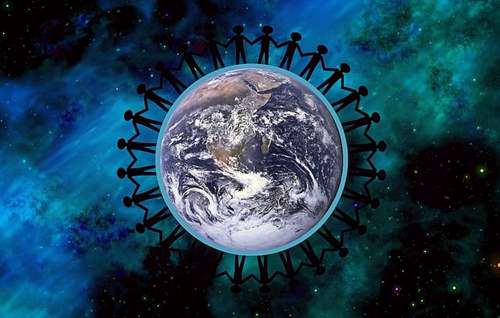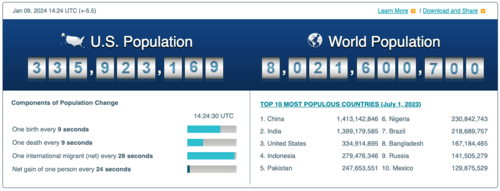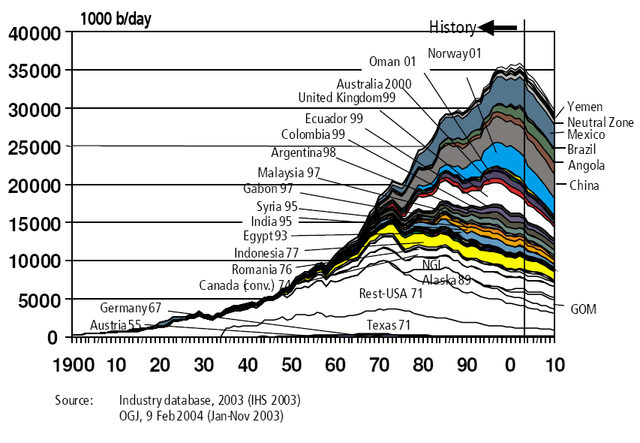未来人类人口增长 -- -- 高级
Section outline
-
Should the of the planet by characterized by individual country, or as one general population?
::地球的特征应该以个别国家为特征,还是以一个普通人口为特征?How many people is too many? Is there a limit? Is there a carrying capacity for humans? These are important questions that do not have an easy answer. But as our population continues to grow, these questions and others should be discussed.
::有多少人太多? 是否有限度? 人类是否有承载能力? 这些都是没有简单答案的重要问题。 但是,随着我们的人口继续增长,这些问题和其他问题应该讨论。Future Population Growth
::未来人口增长Does Earth Have a Carrying Capacity for Humans?
::地球有人类的承载能力吗?As of September 2007, the world’s stood at about 6.7 billion, growing by 211,090 people each day. Historically, we didn’t hit the one-billion mark until 1804 (having begun 200,000 years earlier), but we needed just 12 years to grow by our last billion. The world's population passed 7 billion at the end of October, 2011. Projections by the United Nations and the U.S. Census Bureau predict that by 2050, Earth will host 9.4 billion people; other estimates project that the earth will host 10 to 11 billion people by 2050.
::截至2007年9月,世界人口约为67亿,每天增长211,090人。 从历史上看,我们直到1804年(始于20万年前 ) , 才达到10亿,但我们只需要12年才能增长到最后10亿。 2011年10月底,世界人口超过70亿。 联合国和美国人口普查局预测,到2050年,地球将容纳94亿人口;其他估计预测是到2050年地球将容纳100亿至110亿人口。Cornucopians welcome such growth, believing more people are better for technology and innovation. The model predicts that when all nations are industrialized, the human population will eventually reach a stable level – a carrying capacity of sorts. However, many scientists believe that humans have already overshot the carrying capacity of Earth for our unique levels of resource exploitation and habitat alteration. They and other Neo-Malthusians predict that resource depletion and environmental degradation will eventually lead to famine, epidemics , or war – a Malthusian crisis.
::科农科医生欢迎这种增长,相信更多的人更有利于技术和创新。 模型预测,当所有国家工业化时,人类最终会达到稳定水平 — — 一种承载能力。 然而,许多科学家认为人类已经超额地承受了地球的承载能力,以适应我们独特的资源开发水平和生境改变。 他们和其他新马尔修斯人预测,资源枯竭和环境退化最终将导致饥荒、流行病或战争 — — 马尔图斯危机。Does Earth have a carrying capacity for humans? Recall that carrying capacity is the maximum population size that a particular environment can support without habitat degradation. Ideally, carrying capacity matches population size to resource availability. Although the human population is clearly continuing to grow, many scientists believe that we over-consume resources and exceed the environment’s capacity to cycle nutrients and process waste. They believe that multiple factors will contribute to a crisis in which disease, starvation, or global conflict will cause a population crash or even extinction :
::地球是否具有承载人类的能力?回顾,承载能力是特定环境可以支持的、不会导致生境退化的最大人口规模。 理想的情况是,承载能力与人口规模和可用资源相匹配。 尽管人类人口明显在继续增长,但许多科学家认为,我们过度消耗资源,超过了环境循环营养和处理废物的能力。 他们认为,多重因素将引发一场危机,疾病、饥饿或全球冲突将引发人口崩溃甚至灭绝:-
Our current agricultural system, globally transformed by the
Green Revolution
of the mid-20
th
century, depends heavily on nonrenewable
fossil fuels
for fertilizers, pesticides, and irrigation. Ecologist and agriculturalist David Pimentel predicts that to avert disaster, the U.S. must reduce its population to a maximum of 200 million and the world population must drop to 1/3 its current level. Distribution of
food
has long been a problem and today has some rather ironic consequences: A 2006 MSNBC report claimed, "There are an estimated 800 million undernourished people and more than a billion considered overweight worldwide."
::我们目前的农业体系在20世纪中叶的绿色革命下发生了全球性转变,它严重依赖不可再生的化肥、杀虫剂和灌溉化石燃料。 生态学家和农业学家大卫·皮门特(David Pimentel)预测,为避免灾难,美国必须将其人口减少到最多2亿,世界人口必须下降到目前水平的三分之一。 粮食分配长期以来一直是一个问题,今天也有一些相当具有讽刺意味的后果:2006年MSNBC报告宣称 : “ 全世界估计有8亿营养不良人口,超过10亿被认为超重的人口。 ”
The U.S. population passed 300 million on October 17, 2006. The U.S. and World Population Clocks are maintained by the U.S. Census Bureau online at: https://www.census.gov/popclock/ -
Both developing and developed countries depend almost entirely on
petroleum
to fuel industrialization and transportation, as well as
. In 1956, geophysicist Marion Hubbert predicted that world oil production would peak about half a century into the future and then decline, initiating a global crisis.
Predictions
about the consequences of "Peak Oil" range from successful
of alternative fuels, to collapse of the global industrialized economy, to intense nationalism and war. Some analysts, such as
energy
banker Matthew Simmons, believe that the Peak has already occurred (
Figure
). Others, like energy industry consultants Wood McKenzie, believe we will not reach the peak for another ten years. The difference does not seem significant, but ten years would allow more time for development of alternative fuels and institution of
measures.
::发展中国家和发达国家几乎完全依赖石油来推动工业化和运输,还有 。 1956年,地球物理学家玛莉恩·赫伯特预测世界石油产量将在未来半个世纪内达到顶峰,然后会下降,从而引发一场全球危机。 对“石油石油”后果的预测范围从替代燃料的成功、全球工业化经济的崩溃、强烈民族主义和战争不等。 一些分析家,如能源银行行长马修·西蒙斯(Matthew Simmons)认为峰已经发生了(Figure ) 。 其他分析家,如能源行业顾问伍德·麦肯齐(Wood McKenzie)(Wood McKenzie)(Wood McKenzi)(Mekenzie)(Figure ) , 认为我们在未来十年内不会达到顶峰。 差异似乎不大,但十年内将允许更多时间开发替代燃料和制定措施。
Oil production outside OPEC and former Soviet Union countries has already peaked, according to oil industry databases for 2003 and 2004. -
Fresh
supplies are declining due to pollution and overuse. According to the United Nations, 2.6 billion people lack water for sanitation, and 1.1 billion have inadequate supplies of safe drinking water. Irrigation and overuse have seriously reduced
groundwater
supplies, and
threatens
as well as human sources. Waterborne diseases and lack of water for sanitation cause up to 80% of human illness. Growing populations, of course, will worsen this water crisis.
::根据联合国的数据,26亿人缺乏卫生用水,11亿人缺乏安全饮水供应,灌溉和过度使用严重减少了地下水供应,威胁到人类来源,水媒疾病和缺乏卫生用水导致人类疾病高达80%。 当然,人口增长将加剧水危机。
-
due to agriculture, urban sprawl, and mining is the number one cause of extinction today, precipitating a biodiversity crisis. The World Resources Institute estimates that agriculture has displaced 1/3 of all
and
forests and ¼ of all grasslands; in the U.S., less than 2% of native prairie
remain. Stephen Hawking calculates that continuation of the last 200 years’ rate of
would have us all standing shoulder-to-shoulder, literally.
::由于农业、城市无计划扩张和采矿是今天灭绝的首要原因,引发了生物多样性危机。 世界资源研究所估计,农业已经使三分之一的人流离失所,森林和四分之一的草原仍然保留着。 在美国,不到2%的原地草原。 史蒂芬·霍金估计,继续维持过去200年的速度会让我们肩肩并肩地站立。
-
Burning fossil fuels has brought about
atmospheric change
.
::燃烧化石燃料带来了大气变化。
Sulfur and nitrogen emissions cause , which destroys , lakes, forests, and limestone structures. CO 2 emissions lead to . Earth's surface air temperatures have risen 0.74°C (1.33°F) during the last 100 years, and will continue to rise by 1.1 to 6.4 °C (2.0 to 11.5 °F) by 2100, according to the Intergovernmental Panel on Climate Change (IPCC).
::根据政府间气候变化专门委员会(气专委)的资料,硫和氮排放导致硫和氮排放,破坏湖泊、森林和石灰岩结构,二氧化碳排放导致.地球表面空气温度在过去100年中上升了0.74°C(1.33°F),到2100年将继续上升1.1至6.4°C(2.0至11.5°F)。Food, oil, water, land, and air crises support the idea that our human population has already grown beyond carrying capacity with respect to environmental degradation. As world population continues to grow, what can we do to avert famine, disease, or war? How can we prevent a crash? What should be our goal?
::粮食、石油、水、土地和空中危机支持这样一种观点,即我们的人类人口已经超过了承受环境退化的能力。 随着世界人口的继续增长,我们能够做些什么来避免饥荒、疾病或战争?我们如何防止崩溃?我们的目标应该是什么?Fortunately, individuals, organizations, and governments are beginning to address these problems. The concept of sustainability as a goal for human activities may hold promise for economic, social, and environmental decision-making. Although the term is recent, the concept is clearly expressed in the Great Law of the Iroquois Confederacy:
::幸运的是,个人、组织和政府正开始着手解决这些问题。 可持续性作为人类活动目标的概念可能给经济、社会和环境决策带来希望。 尽管这个术语是最近才出现的,但这一概念在《伊罗科联合大法》中得到了明确表述:"In our every deliberation we must consider the impact of our decisions on the next seven generations." Native American proverb
::"在每次审议中,我们必须考虑 我们的决定对后七代人的影响"A sustainable activity or state can be maintained indefinitely, without compromising resources for the future. Sustainability of products and services considers complete life cycles – raw materials, manufacturing, transportation/distribution, use and re-use, maintenance, recycling and ultimate disposal. All phases must address conservation of natural and human resources and also biodiversity. Many people believe current population and lifestyles are not sustainable. Unequal distribution of resources suggests that developing countries may accelerate pressure on resources in order to improve their own lifestyles.
::可持续活动或国家可以无限期地维持下去,同时又不牺牲未来资源。 产品和服务的可持续性考虑的是完整的生命周期 — — 原材料、制造业、运输/分配、使用和再利用、维护、再循环和最终处置。 所有阶段都必须解决自然和人力资源保护以及生物多样性问题。 许多人认为当前的人口和生活方式是不可持续的。 资源分配不均意味着发展中国家可以加速资源压力以改善自己的生活方式。A preliminary tool for estimating sustainability is an ecological footprint analysis. Your ecological footprint is the amount of land area you would need to sustain your current lifestyle. Footprint analysis considers the resources you consume and the pollution you generate, and then calculates the amount of land which would be needed to produce equivalent renewable resources and process associated with waste. Air, land, water, food, and are all incorporated into the model. You can estimate your own footprint online and compare it to that of countries throughout the world ( Figure ).
::评估可持续性的初步工具是生态足迹分析。您的生态足迹是您维持当前生活方式所需的土地面积。足迹分析考虑了您消费的资源和您造成的污染,然后计算了产生等量可再生资源以及与废物相关的过程所需的土地数量。空气、土地、水、食物,都被纳入模型。您可以在网上估算自己的足迹,并将其与世界各国的足迹进行比较(图 )。Ecological footprints measure the amount of land area required to sustain (produce replacement resources and assimilate waste) particular lifestyles. To date, there is no overall agreement on a carrying capacity of Earth for humans, but many people are concerned about population growth, resource depletion and environmental degradation. Joel E. Cohen, in his book How many people can the earth support ? summarizes three potential responses to the “population problem” identified at the beginning of the chapter. All three can contribute to the ultimate solution.
::迄今为止,尚未就地球对人类的承载能力达成全面协议,但许多人对人口增长、资源耗竭和环境退化感到关切。 Joel E. Cohen在他的著作《地球能支持多少人? 》中总结了对本章开头所确定的“人口问题”的三种潜在对策。 这三个办法都有助于最终解决问题。-
“Make a bigger pie.”
Use technology and innovation to create, conserve, and distribute resources.
::利用技术和创新创造、保存和分配资源。 -
“Put fewer forks on the table.”
Through birth control and cultural change, reduce both population size and lifestyle expectations.
::通过节育和文化变革,减少人口规模和对生活方式的期望。 -
“Teach better manners.”
Transform political and social structures toward the goal of social justice.
::将政治和社会结构转变为社会正义的目标。
The human population, like all populations, has the capacity to reproduce exponentially and yet must live within a finite world. Unique among , however, we can utilize technology, cultural planning, and values in decisions which influence our future welfare. Which tools would you choose? What decisions will you help to make?
::人类和所有人口一样,有能力成倍繁殖,但必须生活在一个有限的世界中。 然而,在影响我们未来福利的决策中,我们可以利用技术、文化规划和价值观。 你会选择哪些工具?你会帮助做哪些决定?Summary
::摘要-
Potential solutions to the problems of population growth are summarized by Joel E. Cohen:
::若埃尔·科恩总结了解决人口增长问题的潜在办法: -
Many scientists believe that we humans have already overshot the carrying capacity of Earth if resource exploitation and habitat alteration are considered.
::许多科学家认为,如果考虑到资源开发和生境改变,我们人类已经超过地球的承载能力。 -
Despite recent declines in birthrate in some developed countries, the human population will continue to increase at least until a peak in 2050 of 9.4 billion people or more.
::尽管最近一些发达国家的出生率有所下降,但人类人口将继续增加,至少到2050年达到94亿或更多人口的高峰为止。 -
Increasing human population can have several effects such as:
-
Agricultural dependence on nonrenewable fossil fuels for fertilizers, pesticides, and irrigation.
::农业在化肥、杀虫剂和灌溉方面依赖不可再生化石燃料。 -
Dependence of industry and transportation on a finite fossil fuel supply, which has already peaked.
::工业和运输依赖有限的矿物燃料供应,这种供应已经达到顶峰。 -
Decline in freshwater resources due to pollution and overuse.
::由于污染和过度使用,淡水资源减少。 -
Habitat destruction due to urban sprawl and agriculture, and a consequent biodiversity crisis.
::由于城市无计划扩张和农业以及随之而来的生物多样性危机,生境受到破坏。 -
Atmospheric changes such as acid rain and global warming – both consequences of increased fossil fuel burning.
::酸雨和全球暖化等大气变化, 两者都是化石燃料燃烧增加的后果。
::不断增长的人类人口可以产生若干影响,例如:农业对不可再生化石燃料的肥料、杀虫剂和灌溉依赖农业。 工业和运输依赖有限的化石燃料供应,这一供应已经达到顶峰。 由于污染和过度使用,淡水资源减少。 城市无计划扩张和农业造成的生境破坏以及随之而来的生物多样性危机。 酸雨和全球暖化等大气变化 — — 两者都是化石燃料燃烧增加的后果。 -
Agricultural dependence on nonrenewable fossil fuels for fertilizers, pesticides, and irrigation.
-
The concept of sustainability may hold promise for economic, social, and environmental decisions.
::可持续性概念可为经济、社会和环境决策带来希望。 -
Sustainability of products and services considers complete life cycles from raw materials to disposal.
::产品和服务的可持续性考虑到从原材料到处置的整个生命周期。 -
A tool for estimating sustainability is the ecological footprint.
-
Create new and conserve existing resources – the technological “fix.”
::创造新的并保护现有资源 — — 技术“固定 ” 。 -
Lower population size and lifestyle expectations – cultural change.
::人口规模小,生活方式期望低 — — 文化变革。 -
Distribute resources equitably – social justice.
::公平分配资源 — — 社会正义。
::评估可持续性的一个工具是生态足迹。 创造新的并保护现有资源 — — 技术“固定 ” ( fix ) 。 人口规模和生活方式期望的降低 — — 文化变革。 公平分配资源 — — 社会正义。 -
Create new and conserve existing resources – the technological “fix.”
Review
::回顾-
Summarize 5 environmental effects of human activity which may act as limiting factors for population growth. How many of these relate to our use of fossil fuels, and why is this a problem?
::总结了人类活动的5种环境影响,这些影响可能成为人口增长的限制因素,其中有多少与我们使用矿物燃料有关,为什么这是一个问题? -
Explain how ecological footprints measure sustainability, and compare them for developed and undeveloped nations.
::解释生态足迹如何衡量可持续性,并比较发达国家和不发达国家的可持续性。 -
Explain what Joel E. Cohen meant by suggesting that “a bigger pie,” “fewer forks,” and “manners” are needed to address the problems of overpopulation.
::解释Joel E. Cohen的意思是,为了解决人口过多的问题,需要“更大的派”、“feeworks,”和“manners”。 -
Consider what you know about resource limitations, population distribution, levels of consumption, technology, poverty, economics, political realities, religious views, and different human perspectives on the earth. Choose and describe 3 changes you believe would be most successful in solving the problems of worldwide population growth – and 3 changes you believe would be least successful. Support each change with reasons why you think it would be more or less effective.
::想想你对资源限制、人口分布、消费水平、技术、贫困、经济学、政治现实、宗教观点以及地球上不同人的观点所知道的。 选择和描述三个你认为最能解决世界人口增长问题的改变 — — 三个你认为最不会成功的改变。 支持每项改变的理由是认为它会有效或无效。
-
Our current agricultural system, globally transformed by the
Green Revolution
of the mid-20
th
century, depends heavily on nonrenewable
fossil fuels
for fertilizers, pesticides, and irrigation. Ecologist and agriculturalist David Pimentel predicts that to avert disaster, the U.S. must reduce its population to a maximum of 200 million and the world population must drop to 1/3 its current level. Distribution of
food
has long been a problem and today has some rather ironic consequences: A 2006 MSNBC report claimed, "There are an estimated 800 million undernourished people and more than a billion considered overweight worldwide."



